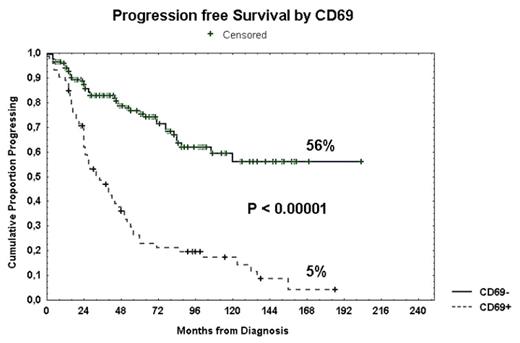Abstract
CD69 membrane protein is expressed early in the activation of lymphoid cells and is inducible by B-cells through cross-linking of surface immunoglobulins. Moreover, B-CLL cells exhibit features of activated and of antigen-experienced B lymphocytes overexpressing activation markers such as CD23, CD25, CD69 and CD71 (Damle, 2002). Furthermore, we have demonstrated that ZAP-70+ CLL subgroup shows a rapid disease progression and an inferior overall survival (Del Principe, 2006). The generation of antimurine CD69 monoclonal antibodies able to induce down-modulation or partial depletion of CD69+ cells (Sancho, 2006), prompted us to evaluate the real impact of CD69 expression on B-CLL prognosis. The primary aims of our study were:
to determine progression-free survival (PFS) and overall survival (OS) upon CD69 expression;
whether CD69 could predict varied outcome within ZAP-70+ and ZAP-70 negative subgroups; and finally
whether CD69 was an independent prognostic factor. Therefore, we investigated 247 pts, median age 65 years, 131 males and 116 females.
With regard to modified Rai stages, 69 pts had a low stage, 167 an intermediate stage and 11 a high stage. CD69 was determined by multicolor flow cytometry fixing a cut-off value of 30%. CD69+ B-CLL pts were 73/247 (30%). CD69 >30% was significantly associated with an intermediate/high Rai stage (p=0.001), lymphocyte doubling time (LDT) <12 months (p=0.00005) and beta-2 microglobulin >2.2 mg/dl (p=0.002). Lower CD69 expression and IgVH mutated status (>2%) were significantly correlated (73/92; p=0.0003). Furthermore, we found significant associations between lower CD69 and lower CD38 (137/184; p=0.02) or lower ZAP-70 (110/144; p=0.01). Lower levels of soluble CD23 (sCD23) were strongly associated with lower CD69 (127/158; p<0.00001). With regard to clinical outcome, both a significant shorter PFS (Figure) and OS were observed in CD69+ pts (5% vs 56% at 14 years; p<0.00001 and 44% vs 66% at 14 years; p=0.00001) as well as in ZAP-70+ pts (7% vs 62% at 12 years; p<0.00001 and 26% vs 90% at 14 years; p<0.00001). To further explore the prognostic impact of CD69, we investigated its expression within ZAP-70+ (103 pts) and ZAP-70 negative (144 pts) subsets. CD69+ pts showed a shorter PFS both within the ZAP-70+ subset (11% vs 27% at 8 years; p=0.004) and within the ZAP-70 negative subset (21% vs 79% at 12 years, p<0.00001). In multivariate analysis of PFS and OS, in which Rai modified stages, CD38, sCD23, LDT, CD69 and ZAP-70 entered, both ZAP-70 (p=0.0003 and p=0.0002) and CD69 (p=0.005 and p=0.0004) resulted to be independent prognostic factors. Therefore, CD69, determined by flow cytometry, could be considered as a new promising immunologic prognostic parameter in B-CLL. Furthermore, since the ZAP-70 negative subgroup consists of a heterogeneous population presenting variable outcome, CD69 might better stratify B-CLL subsets and early identify progressive pts in order to take timely therapeutic decisions.
Author notes
Disclosure: No relevant conflicts of interest to declare.


This feature is available to Subscribers Only
Sign In or Create an Account Close Modal